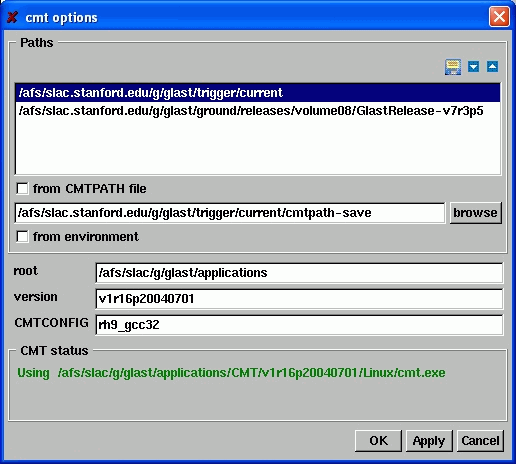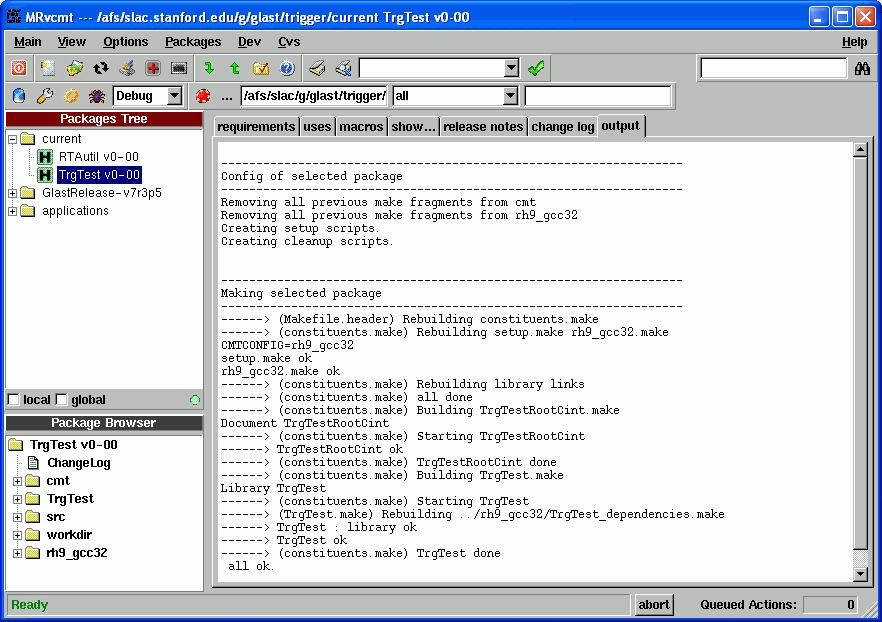...
| Wiki Markup |
|---|
The code CVS repository reside at the $CVSROOT/users/Trg/\[Packagename\] (CVSROOT is /afs/slac/g/glast/ground/cvs on SLAC UNIX). As part of the "users" code, they are not attached to any office release so that you need to check them out and compile yourself for all usage. Because the packages live under users/ subdirectories, some care needs to be taken to not accidentally checkout or tag the whole users package with many people's code (you will regret it\!). The general usage of the users packages are eplianed by Toby in [this posting|http://www-glast.stanford.edu/protected/mail/infrasoft/0852.html]. As an example, if you want to develop the TrgTest code, starting from tag v0-01, under your own release directory _myRelease,_ then the cvs checkout command is:
cd myRelease
cvs co \-r v0-01 \-o users/Trg TrgTest
The \-o option indicates the directory offset for the package. This should make a directory myRelease/TrgTest/v0-01/. Within the package directory, you typically should have a subdirectory with the same name as the package name which contains the class headers; a subdirectory /src containging the class implementation C+\+ source files and the /cmt subdirectory containing the build options. The TrgTest pacakge also has a subdirectory /workdir for running applications in ROOT. When you commit the revised version for Trgtest, you should also issue the cvs commit from the directory myRelease/TrgTest/v0-00/ or it subdirectories to only commit code within the package. When you want to tag an updated version, again you should be sitting in myRelease/TrgTest/v0-01/ and using the \-rtag recommended by Toby for the packages residing in subdirectories:
cvs rtag _TagName_ users/Trg/TrgTest
To check the tags, you need to spell out the full package directory offset:
listtag users/Trg/TrgTest |
CMT Code Build
For packages checked out from CVS, you will work within CMT to build and update them. The interactive CMT GUI is the recommended tool for doing development. It can be started with the command MRvcmt& after the setup is run. The essense of the CMT operations are introduced in the offline workbookunder the tab: MRvcmt. Upon startup of MRvcmt for the first time you need to configure the paths. From the MRvcmt top menu, select the Options tab then "Cmt Options" to bring up the the following panel: !snap-cmt-options!
to control the CMT path directories. You can also check what's in
which is not yet filled. Click the "from CMTPATH file" box and then browse for the /afs/slac/g/glast/trigger/GlastReleasecurrent/cmtpath-save file. Once located and entered the file, the panel should then be loaded with the contents shown above. Uncheck the "from CMTPATH file" box, then change the top line (highlighted in the picture above) of the paths box to whatever your own current working GLAST release directory, then use the save as an example how this is setup for development work in this working area. One typically goes to the GUI GlastRelease folder RTAutil or TrgTest package (by click and highlighting it) then just work under the Dev tab clean/config/Make to build and update the ROOT sharable libraries.button (the little floppy symbol on the top right of the panel) to save this configuration to your own release directory as e.g. mycmtpath. MRvcmt has a cached buffer so that next time you fire up MRvcmt, it will reload the same configuration as last time. With this saved file mycmtpath, you can choose to set the cmtpath file field to this file and check the "from CMTPATH file" box to make sure the configuration will load this file instead next time (this may be useful when developing different things under different releases).
Once done with the CMT configuration options and returned to the MRvcmt main panel. As an example of working in /afs/slac/glast/trigger/current as the release directory, and already used cvs to checkout both RTAutil and TrgTest packages, you should see something like this:
with the two packages shown under the release directory. If you didn't checkout the packages yet, you can also try the top "packages" menu to check out (package name TrgTest, Offset users/Trg). You can then click on e.g. TrgTest v0-00 which will set it to be the current working package. For subsequent work of updating and building the selected package, you pretty much only needs to go to the top menu "Dev" tab to do "Make" (may be occassionally "configure" or "clean" in case of new files added or major structural/build option changes). Note that the build process created the platform binary output directory rh9_gcc32, which in particular contains the ROOT sharable library libTrgTest.so. The cmt subdirectory originally only contains the requirements file, while the Make files are generated by the cmt processing.
Updating/Adding Code
For running some of the existing jobs, the directory /afs/slac/g/glast/trigger/GlastRelease/TrigTest/v0/workdir has a release.setup script which only needs to be run once at creation to establish the softlinks for sharable libraries which only need to be updated when changing base release. The standard set of libraries are loaded through RooLogon.C which gets executed at ROOT startup. Upon firing up ROOT, one can simply do .x RunXXXX.C for the various existing tests, where XXXX can be
...

